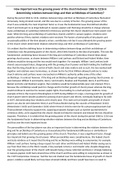How important was the growing power of the church between 1066 to 1216 in
determining relations between kings and their archbishops of Canterbury?
During the period 1066 to 1216, relations between kings and their archbishops of Canterbury fluctuated
immensely, being strained overall, and this was due to a variety of factors. The growing power of the
church was evidently the most important factor as it was the fundamental issue that defined whether
church and state got on as kings believed in caesaro-papism and that kings should be in charge whereas
many archbishops of Canterbury believed in theocracy and that the church should have more power over
state. When the king and archbishop of Canterbury shared a belief in caesaro-papism, relations were
positive whereas if they clashed, relations were strained. The factors of personality of key players and
occasionally politics of the time played a minor, contributory role but it was ultimately the growing power
of the church which determined relations between kings and their archbishops of Canterbury.
It is evident that the defining factor in determining relations between kings and their archbishops of
Canterbury was the growing power of the church, which links heavily to the idea of principles. This was the
fundamental, underlying factor because if the king and archbishop of Canterbury shared ideas about
growing church power, as shown between William I and Lanfranc and Richard and Hubert Walter, then
relations would be strong and the two would work together. For example, William I and Lanfranc both
shared caesaro-papist ideas, disagreeing with the growing church power and both holding the traditional
idea that the king should be in control of both church and state matters and as such, the two worked well
together and relations were harmonious, as shown by the fact that William allowed Lanfranc to make
church reforms and Lanfranc never encroached on William’s authority unlike some of the other
archbishops. In contrast however, if the king and archbishop disagreed regarding growing church power, as
seen between William II and Anselm, Henry I and Anselm, Stephen and Theobald, Henry II and Thomas
Becket and John and Stephen Langton, then relations would be fundamentally poor and strained. This is
because the archbishop would push for change and for further growth of church power whereas the king
would continue to exercise his caesaro-papist rights, thus leading to a clash and poor relations. A key
example of this is the Council of Rockingham in 1095 during William II’s reign, a turning point for growth of
church power where Anselm pushed for growing church power and reform, eventually leading to his exile
in 1097, demonstrating how relations were clearly poor. This clash over principles and growth of church
power can also be seen between Henry II and Thomas Becket during the councils of Woodstock (1163),
Westminster (1163) and Clarendon (1164) where Henry II tried to exercise his caesaro-papist powers but
Thomas Becket refused to support him, opposing proposed changes such as harsher punishments for
criminous clerks, as he argued that the church should not help the monarch and instead the two should be
separate. Therefore, it is evident that the growing power of the church during the period 1066 to 1216 was
the fundamental factor in determining whether relations between the king and archbishop of Canterbury
and thus was the most important factor.
The personalities of the key players was also an important factor in determining the relations between the
king and his archbishop of Canterbury as it exacerbated the fundamental differences or similarities in
principles and beliefs over the growing power of the church. Therefore, it was a significant factor, though
less important that growing church power. When personalities were complimentary, this helped church
and state relations as it meant that the king and his archbishop were willing to compromise, for example
William I and Lanfranc having a deep respect for each other and Richard and Hubert Walter seeing eye to
eye from their time on the third crusade. A key example is Henry I and Anselm who, despite disagreeing
over the growing power of the church with Anselm being a heavy reformist and Henry I strongly believing
in caesaro-papism, both had a shared love of the church and thus were willing to compromise as shown in
the 1107 Compromise. However, had the two not clashed over the fundamental issue of growth of church
power, relations would likely not have been strained initially and there would have been no need to




